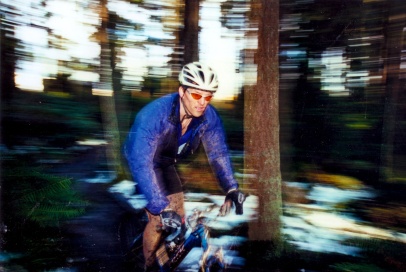Arising early, on a warm sunny Monday morning. I pull on bike shorts and a jersey. Stopping long enough to brew a cup of tea, I head over to my meditation cushion. I struggle to stay focused as I meditate. I know where I am headed – mountain biking on Tiger Mountain. The key to mountain biking is to be in a centered state of fluid surrender. The quiet sitting helps me tune into myself before the thrill of the ride gets my adrenaline pulsing.
After my sit, I grab my tea, feed the kitties and I’m gone! Headed for the ever-fun Preston Railroad Grade trail. Giddy with the feeling of a kid playing hooky I drive to the mountain. At the trailhead I gear up and pedal through the rays of morning sun slanting through the dense canopy of trees.
30 minutes of climbing brings me to the beginning of the downhill single-track. This trail, more than any other I know, will reward a relaxed and confident state of riding and it will punish the rider who fights what the trail presents. Paradox. If I relax my hands on the bars, use the brakes sparingly, and keep my eyes down the trail, then flow, joy, and ease are mine. If I tense up, ride the brakes, hold tight to the grips, and stare intently at each obstacle, then I am sure to experience a tight, fearful, and exhausting descent.
Say what? The harder I try, the slower I go = the scarier and more difficult the ride. The more I relax, the faster I go = the more graceful and fluid the ride.
This takes us into the terrain of what the psychologist Mihaly Csikszentminhalyi called FLOW. “Flow is the mental state of operation in which a person in an activity is fully immersed in a feeling of energized focus, full involvement, and success in the process of the activity.” This state can occur when we successfully focus our attention on those areas that support performance AND in such a way that supports performance. In that sense, we can also say that we are taking our focus away from information that distracts or undermines performance.
Fortunately, I believe we all know that place of being in the zone, on fire, wired in, or centered. The question is how do we slip into this?
Here are a few answers that come from mountain biking. I’ll let you translate these into the environments and activities where you are going for it in your life.
1) Get centered before you start. Remind yourself why you are doing this.
2) Assess your ability and willingness to take on a given trail before you start the ride. If you decide to go for it, then go, and stop worrying about the risks. If it doesn’t feel right, today isn’t your day, then don’t do it. Do or ride something else.
3) Look ahead to see the big picture of your line and commit to it. Focus beyond the current obstacle or challenge. Look where you want to go, not where you don’t want to go.
4) Relax. Hold the handle bars and brakes loosely. Breathe. Over gripping and braking cause fatigue and don’t allow the bike to perform as it is designed.
5) Drop your attention and picture that you are riding from your gut, not your head. Soften the eyes. Smile. Laugh out loud and enjoy the ride! Make “weeee” sounds as you ride.
None of these guarantee success, and there are consequences for failure whether mountain biking, interviewing for a job, or making that big presentation. Yet I can say with confidence that the more we are in flow the less likely we will fall/fail.
<shameless plug> We teach these concepts, and more, through our Centered Leadership course and in our Leadership Practicum. Consider joining us.
Enjoy the sun!






























